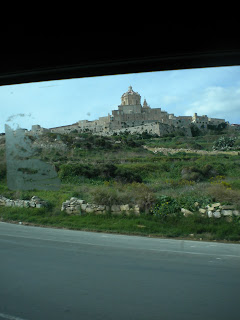Sicily is located at the toe of the Italian boot, where the waters of the Mediterranean, Ionian, and Tynherian Seas meet. The island has been inhabited for tens of thousands of years; long before the first Phoenician and Greek traders and colonizers came ashore. On the east coast of Sicily, between Messina, to the north and Syracuse, to the south, lies the beautiful city of Catania. Though it is not as well-know as other Sicilian cities, Catania, with a population of around 300,000 is the 2nd largest metropolitan area on the island, following Palermo. Catania is actually a city upon a city, upon another and another. Repeated conquests, powerful earthquakes, and Mt. Etna's eruptions have caused the city to be rebuilt time and again.
We passed through Catania and continued to the area of Syracuse. And, the rain continued. Arriving at our destination, The Archaeological Park, we met our guide for the day (with a large umbrella in-hand). The Archaeological Park is the main historic attraction area of Syracuse. Our excursion began with every person cover by an umbrella. The first stop was at the site of the Roman Amphitheater, created during Roman rule. Here, gladiatorial performances were mounted.
And the rain continued to fall. As the guide talked the water gathered until we were all standing in it. Our guide took us inside what appeared to be a small cave where we were protected for a few minutes. But, the water started to run inside the cave and suddenly we were standing in a few inches of water. At this point the group of 16 of us decided that we would spend some time inside the archaeological museum that was located within this park and hope for better weather so our guided tour could continue.
Inside we learned that the highlight of the site is the Greek theater, the most complete theater of its kind existing today. Constructed in the 5th century BC by the Ancient Greeks, plays by Euripides were performed here.
Nearby is the Latomia del Paradiso, one of the quarries from which the great monuments of Syracuse were constructed. It is nicknamed "Dionysius' Ear" after one of the despots of Syracuse, who is reputed to have led prisoners inside. The quarry is renowned for its remarkable acoustics.
Also at the site is the Roman Amphitheater, created during Roman rule. Here, instead of plays, gladiatorial performances were mounted.
But the rain didn't let up. Finally, after approximately 4 hours we decided that we would begin our return to Catania and our ship. As we traveled, concern about the conditions of the streets, i.e. flooded with "rivers" running across low spots convinced that we had made the correct decision to start early our return to the ship. We made it back to the port with no incident and back on the ship before our 4:45 p.m. scheduled sailing time.
So, on another trip we'll have Sicily on our "to visit" list.










































































